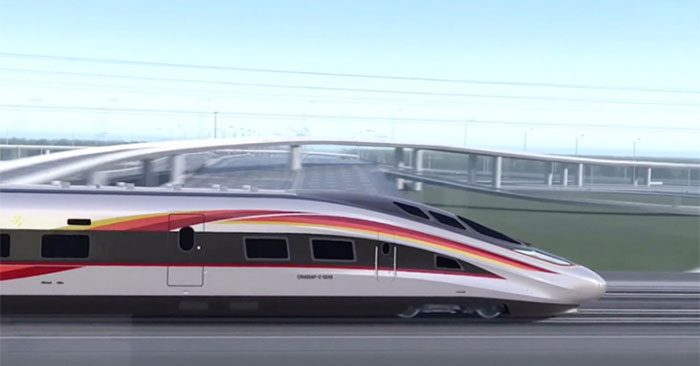Chinese scientists have announced a solution that will enable the CR450 bullet train to run smoothly at speeds of 400 km/h by 2025.
Currently, China’s fastest trains reach a maximum speed of about 350 km/h, providing passengers with an extremely smooth experience with minimal motion disturbances inside the carriages. However, the country plans to launch a new bullet train model in 2025 that can achieve speeds of 400 km/h—an acceleration that only a few commercial supercars, such as the Bugatti Veyron, can attain.
At such high speeds, even a minor collision can cause the entire train to shake. During a long journey, such as the nearly 2,000 km trip from Hong Kong to Beijing, persistent vibrations can lead to motion sickness among passengers.
The research team, led by Professor Shi Jin from Beijing Jiaotong University, stated that this issue could be addressed by adjusting the height of the tracks by just a few millimeters at certain “sensitive points.”
Shi and his colleagues at the National Key Laboratory of High-Speed Railway Technology in Beijing conducted computer simulations and experimental tests, which demonstrated that their method is indeed effective.

China’s CR400 bullet train currently reaches a maximum speed of 350 km/h, but the new generation CR450 could increase this to 400 km/h. Photo: Xinhua
“The operational speed of high-speed trains reflects the level of technological development of a country,” Shi wrote in a paper published last month in the journal Railway Science & Engineering. “As trains run faster, the interaction between the wheels and the tracks increases, making existing measures to reduce vibrations during the journey less effective.”
According to the research team’s calculations, the vibrations passengers experience at 400 km/h will be 5% higher than current levels. While this may seem like a minor difference, it could increase the wavelength of perceivable oscillations along the train body by 15%. If not effectively controlled, this could lead to discomfort for passengers throughout the journey and even pose safety risks.
The study indicates that raising the sleepers—concrete beams supporting the metal rails—by just a few millimeters could counteract this effect. However, if this solution proves effective in practice, it will significantly increase the workload for railway maintenance teams, according to a high-speed railway engineer in Beijing who was not involved in the research. The anonymous engineer noted that a 300 km stretch of high-speed rail requires nearly one million sleepers for support.
Trains operating at different speeds can run on the same track, but each speed setting requires different specifications for the sleepers. China’s current safety standards only allow for minute tolerances in millimeters when adjusting the sleepers.
China has more than 40,000 km of operational high-speed rail. Ensuring that all of them are compatible with 400 km/h trains will be a challenging task. However, a solution needs to be found soon, as the government’s five-year plan states that the new generation of high-speed trains, the CR450, will be completed and operational in less than three years.
Earlier this year, Wang Feng, the president of CRRC Changchun Railway Vehicles, a state-owned manufacturer of locomotives in China, mentioned that the CR450 could potentially be improved to reach speeds of up to 600 km/h.
However, in an article published in the journal Urban Mass Transit, he cautioned that trains traveling at 400 km/h have a stopping distance of 6 km, necessitating additional measures to ensure passenger safety, such as warning systems and automated driving using artificial intelligence.
Wang also emphasized that the CR450 is more environmentally friendly, consuming 18% less energy than the current 350 km/h trains. Separate research by Chinese scientists shows that carbon emissions from high-speed rail are only 6% of those from air travel and 11% of those from cars.


















































